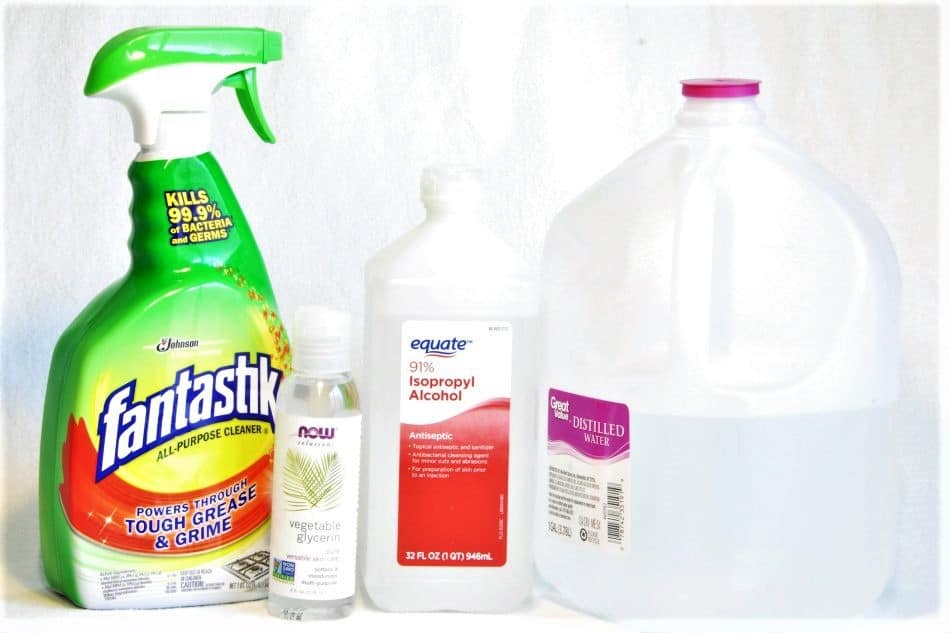Airbrush paint thinners & cleaners can be expensive. But have you ever thought of making your own homemade airbrush reducer / cleaner from scratch? Well, that is the goal today. Not only is it going to be cheaper to go the home brew way, but it’s super simple to make, and odds are, you’ll have the necessary ingredients at home!
To be honest, I had been stuck on this Idea of making my own paint thinner / cleaner for quite some time… I did all sorts of research, along with a bunch of testing / comparing with different home brewed recipes on the internet and after much consideration, I have come up with a few recipes that I feel are the best.
I have found that a few of the recipes below act quite similar to some of the major airbrush paint thinners / cleaners being sold on the market today.
However, keep in mind, these recipes aren’t exactly to spec on what the big name brands are putting in their reducers and cleaners. For the most part, the ingredients found below are either close to, or substitutes for the ingredients commonly found in the big name airbrush paint reducers and cleaners.
With that being said. If you have any doubts with the recipes below. My best advice would be to stick with the branded thinners when working on projects of high value. And simply use the below recipes on practice projects.
Nonetheless, those that were willing to share their home made thinner / cleaner recipes below do in fact use their recipes to thin their paint, even when working on high value projects.
But without further adieu, let’s dive into the best homemade recipes I have found, and the one I currently use.
Do note, airbrush paint reducer can commonly be used as a cleaning agent. This means, for the most part, the same concoction you use to reduce your paints, can also be used for cleanup of the paint as well. So essentially the recipes below are for both paint reducer, as well as paint cleaner.
Best Homemade Airbrush Paint Thinners / Cleaners
I must specify, the below formulas for creating your own airbrush thinner / cleaner (At home) are meant to be used with water based acrylic paints, inks and so forth… When working with solvent based paints you are going to require a different subset of solvents for paint reduction and cleanup of those paints.
Now, you will likely notice similarities between each of the following recipes. This is because, over the years these are the major ingredients that the airbrush community has found to do the best when mixing up your own home brewed airbrush reducer / cleaner.
If you scour the internet, you will find other recipes for making your own homemade airbrush thinner / cleaner. However, many of those other recipes include ingredients that are said to be harmful to an airbrush.
For instance,
Some like to use Windex in their home brew reducers / cleaners. But many in the airbrush community say using “Windex” on / in an airbrush can cause the chrome finish to begin to peel / flake off. This is due to the ammonia that is in the Windex.
Now it’s said this occurs if the Windex is left marinating in the airbrush for an extended period of time. But I’d suspect even small exposure periods could do some harm over time.
Another Issue with using ammonia based products for thinning paint is that some say ammonia will break down the paint…
Now, I’m not sure exactly how true either of these assumptions are about using ammonia for paint reduction, and cleanup. However, I simply prefer to stay on the safe side and avoid anything that is of a high ammonia count. But of course you are free to do as you please.
That being said, let’s dive into the top home brewed airbrush paint thinner and cleaner recipes available on the internet.
Recipe # 1
I stumbled across this recipe a while back and have found it to work the absolute best for my needs when compared to the line up of different recipes listed on this page. It makes applying the paint to plastic as well as paper similar to that of the paint thinner sold by the paint manufacturer.
And Yes, I have actually compared each of these home brew recipes to the actual reducer recommended for the airbrush paint I use (Createx). And this recipe literally comes the closest to achieving the same result as seen with the manufacturers recommended reducer.
And by “closest”, I mean, the paint acted basically the same as it did when compared to the recommended reducer from Createx.
- 4 Cups Distilled Water
- 1 Cup Rubbing Alcohol 99% or 91% (Link To Amazon)
- 1 Cup Fantastik All-Purpose Cleaner (Link To Amazon)
- 5 Drops Glycerin (Link To Amazon)
Recipe # 2
This recipe worked well for me. However (and this may be dependent on the paint brand I’m using “Createx”), I noticed when trying to apply it to plastic parts. The paint adhesion wasn’t near as good as when using the manufactured reducer meant for the paint.
But when using it on paper there were no issues at all. Granted I was using a brush when I applied it. But the test scenario was done the same using this recipe as the reducer manufactured for the paint.
I simply found this recipe struggled to adhere well to plastic when the paint was applied using a paint brush. But using an airbrush its a different story.
- 2/3 Distilled Water
- 1/3 Isopropyl Alcohol 99% (Link To Amazon
- 1 Drop Of Glycerine (Per ever 50 ML’s) (Link To Amazon)
Recipe # 3
Likely the simplest out of the line up of recipes listed here. But that doesn’t mean it isn’t a great recipe.
For me, This recipe worked similar to that of recipe # 1 above. However using this recipe I had a lot of soap suds inside my airbrush paint cup which began to get annoying. But didn’t make much of a difference on the end result.
- 25% Fantastik All-Purpose Cleaner (Link To Amazon)
- 75% Distilled Water (You can use regular tap water, but distilled is a safer bet as it won’t have impurities in it)
Conclusion
There a many different home brew recipes for making your own airbrush paint thinner, and cleaner on the Internet. But after testing many of them, It came down to the 3 listed above that I preferred the most, And found the most success with.
With the options above, I believe you will find a recipe that works well for you and the current paint your using. Assuming your using water based paints. Because, remember, the above recipes are only ideal for water based paints. Not solvent based.
Anyway, I hope you were able to find some value here! If you have any further questions regarding the airbrush do be sure to take a look around the website. Airbrush Insider is dedicated to helping all in the airbrush community!
This is Colt signing off!
Check Out Some Of My Favorite Airbrush Equipment:
- My Favorite Airbrush To Date!
- The Air Compressor I Currently Use, And Why I’m Never Going Back To A Traditional “Airbrush Compressor”!
- My All Time Favorite Airbrush Paint’s For Ease Of Use & Versatility!
Next Resources:
Now that you have a new home brew recipe for reducing and cleaning your paints. Ensure you are thinning your paint properly by reviewing my ultimate paint reduction guide to thin paint for an airbrush.
As well, ensure you are cleaning your airbrush correctly by taking a look at my in depth Airbrush cleaning guide. Because as we all know, a clean airbrush is a happy airbrush.

